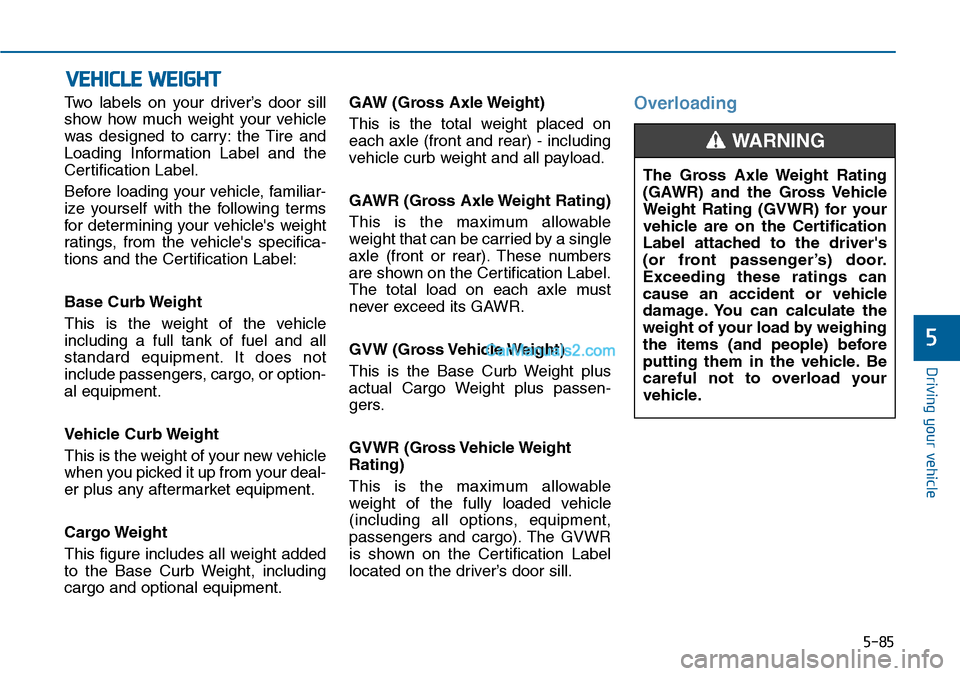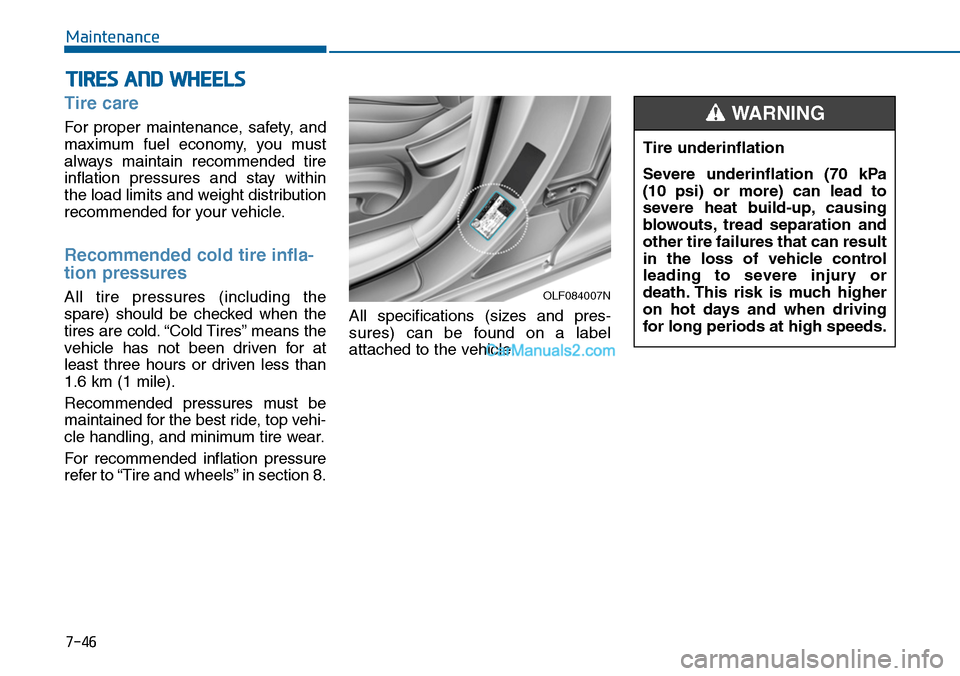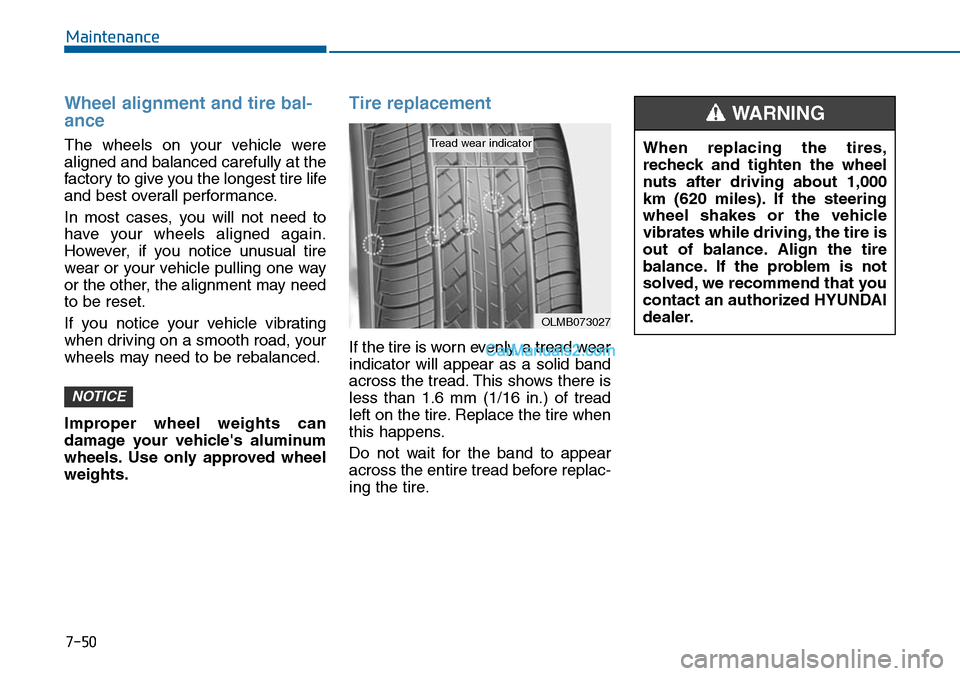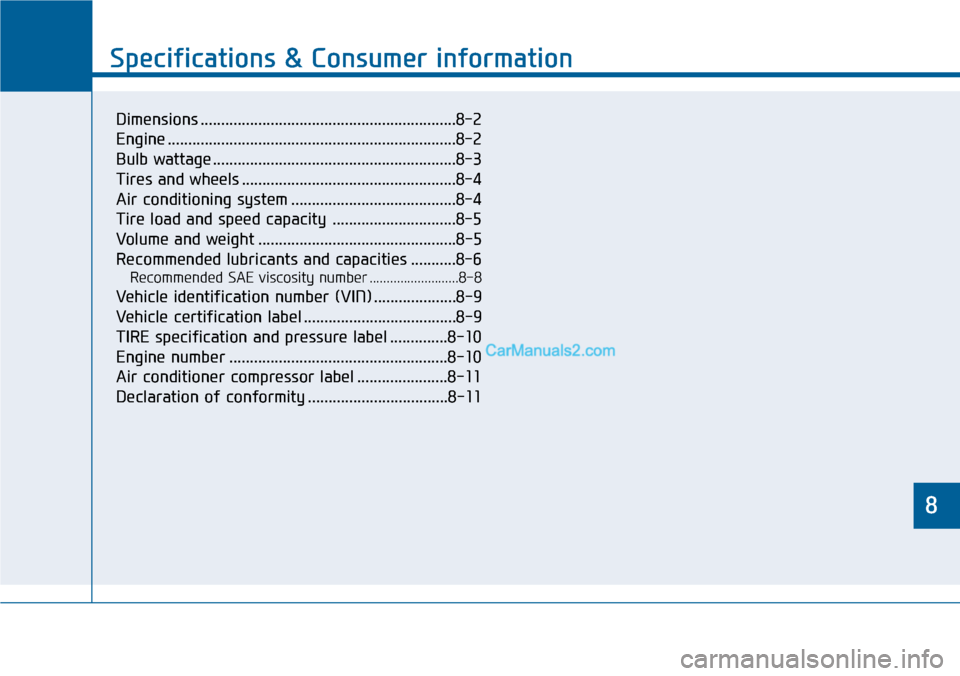Page 534 of 665

5-85
Driving your vehicle
5
Two labels on your driver’s door sill
show how much weight your vehicle
was designed to carry: the Tire and
Loading Information Label and the
Certification Label.
Before loading your vehicle, familiar-
ize yourself with the following terms
for deter mining your vehicle's weight
ratings, from the vehicle's specifica-
tions and the Certification Label:
Base Curb Weight
This is the weight of the vehicle
including a full tank of fuel and all
standard equipment. It does not
include passengers, cargo, or option-
al equipment.
Vehicle Curb Weight
This is the weight of your new vehicle
when you picked it up from your deal-
er plus any aftermarket equipment.
Cargo Weight
This figure includes all weight added
to the Base Curb Weight, including
cargo and optional equipment.
GAW (Gross Axle Weight)
This is the total weight placed on
each axle (front and rear) - including
vehicle curb weight and all payload.
GAWR (Gross Axle Weight Rating)
This is the maximum allowable
weight that can be carried by a single
axle (front or rear). These numbers
are shown on the Certification Label.
The total load on each axle must
never exceed its GAWR.
GVW (Gross Vehicle Weight)
This is the Base Curb Weight plus
actual Cargo Weight plus passen-
gers.
GVWR (Gross Vehicle Weight
Rating)
This is the maximum allowable
weight of the fully loaded vehicle
(including all options, equipment,
passengers and cargo). The GVWR
is shown on the Certification Label
located on the driver’s door sill.
Overloading
VEHICLE WEIGHT
The Gross Axle Weight Rating
(GAWR) and the Gross Vehicle
Weight Rating (GVWR) for your
vehicle are on the Certification
Label attached to the driver's
(or front passenger’s) door.
Exceeding these ratings can
cause an accident or vehicle
damage. You can calculate the
weight of your load by weighing
the items (and people) before
putting them in the vehicle. Be
careful not to overload your
vehicle.
WARNING
Page 603 of 665

7-46
Maintenance
TIRES AND WHEELS
Tire care
For proper maintenance, safety, and
maximum fuel economy, you must
always maintain recommended tire
inflation pressures and stay within
the load limits and weight distribution
recommended for your vehicle.
Recommended cold tire infla-
tion pressures
All tire pressures (including the
spare) should be checked when the
tires are cold. “Cold Tires” means the
vehicle has not been driven for at
least three hours or driven less than
1.6 km (1 mile).
Recommended pressures must be
maintained for the best ride, top vehi-
cle handling, and minimum tire wear.
For recommended inflation pressure
refer to “Tire and wheels” in section 8.
All specifications (sizes and pres-
sures) can be found on a label
attached to the vehicle.
Tire underinflation
Severe underinflation (70 kPa
(10 psi) or more) can lead to
severe heat build-up, causing
blowouts, tread separation and
other tire failures that can result
in the loss of vehicle control
leading to severe injury or
death. This risk is much higher
on hot days and when driving
for long periods at high speeds.
WARNING
OLF084007N
Page 607 of 665

7-50
Maintenance
Wheel alignment and tire bal-
ance
The wheels on your vehicle were
aligned and balanced carefully at the
factor y to give you the longest tire life
and best overall performance.
In most cases, you will not need to
have your wheels aligned again.
However, if you notice unusual tire
wear or your vehicle pulling one way
or the other, the alignment may need
to be reset.
If you notice your vehicle vibrating
when driving on a smooth road, your
wheels may need to be rebalanced.
Improper wheel weights can
damage your vehicle's aluminum
wheels. Use only approved wheel
weights.
Tire replacement
If the tire is worn evenly, a tread wear
indicator will appear as a solid band
across the tread. This shows there is
less than 1.6 mm (1/16 in.) of tread
left on the tire. Replace the tire when
this happens.
Do not wait for the band to appear
across the entire tread before replac-
ing the tire.
NOTICE
OLMB073027
Tread wear indicatorWhen replacing the tires,
recheck and tighten the wheel
nuts after driving about 1,000
km (620 miles). If the steering
wheel shakes or the vehicle
vibrates while driving, the tire is
out of balance. Align the tire
balance. If the problem is not
solved, we recommend that you
contact an authorized HYUNDAI
dealer.
WARNING
Page 656 of 665

8
Specifications & Consumer information
8
Specifications & Consumer information
8
Dimensions ..............................................................8-2
Engine ......................................................................8-2
Bulb wattage ...........................................................8-3
Tires and wheels ....................................................8-4
Air conditioning system ........................................8-4
Tire load and speed capacity ..............................8-5
Volume and weight ................................................8-5
Recommended lubricants and capacities ...........8-6
Recommended SAE viscosity number ..........................8-8
Vehicle identification number (VIN) ....................8-9
Vehicle certification label .....................................8-9
TIRE specification and pressure label ..............8-10
Engine number .....................................................8-10
Air conditioner compressor label ......................8-11
Declaration of conformity ..................................8-11
Page 659 of 665

8-4
Specifications & Consumer information
TIRES AND WHEELS
Item Tire sizeWheel
size
Inflation pressure, bar (kPa, psi)Wheel lug nut
torque
kg•m (lb•ft, N•m)
Normal load *1Maximum load
Front Rear Front Rear
Full size tire
205/65R16 6.5JX16 2.35 (235, 34) 2.35 (235, 34) 2.35 (235, 34) 2.35 (235, 34)
9~11
(65~79, 88~107)
215/55R17 7.0JX17 2.35 (235, 34) 2.35 (235, 34) 2.35 (235, 34) 2.35 (235, 34)
235/45R18 7.5JX18 2.35 (235, 34) 2.35 (235, 34) 2.35 (235, 34) 2.35 (235, 34)
Compact spare tire
(if equipped)
T125/80D164.0TX164.2 (420, 60)4.2 (420, 60)4.2 (420, 60)4.2 (420, 60)
T135/80D174.0TX174.2 (420, 60)4.2 (420, 60)4.2 (420, 60)4.2 (420, 60)
When replacing tires, use the same size originally supplied with the vehicle.
Using tires of a different size can damage the related parts or not work properly.
CAUTION
*1 :Normal load :Up to 3 persons
AIR CONDITIONING SYSTEM
ItemsWeight of Volume Classification
Refrigerant
g (oz.)
Theta 2.0T-GDI550 ± 25g (19.5 ± 0.8)
R-134aTheta 2.4MPI
650 ± 25g (22.9 ± 0.8)GDI
Nu 2.0MPI
Compressor lubricant
g (oz.) 100 ± 10 (3.52 ± 3.5)PA G ( F D 4 6 X G )
Contact an authorized HYUNDAI dealer for more details.
Page 660 of 665
8-5
8
Specifications & Consumer information
TIRE LOAD AND SPEED CAPACITY
*1LI : LOAD INDEX*2SS : SPEED SYMBOL
Item Tire size Wheel sizeLoad Capacity Speed Capacity
LI *1kg SS *2km/h
Full size tire
205/65R16 6.5JX16 95 690 H 210
215/55R17 7.0JX17 94 670 V 240
235/45R187.5JX1894670V240
Compact spare tire
(if equipped)
T125/80D164.0TX1697730M130
T135/80D174.0TX17103875M130
VOLUME AND WEIGHT
Items
Theta 2.0Theta 2.4Nu 2.0
T-GDIMPIGDIMPI
A/TA/TA/TM/T
Gross vehicle weight
kg (lbs.)2120 (4674)2100 (4630)2040 (4497)1960 (4321)2020 (4453)
Luggage volume
l(cu ft)462 (16.3)
Page:
< prev 1-8 9-16 17-24